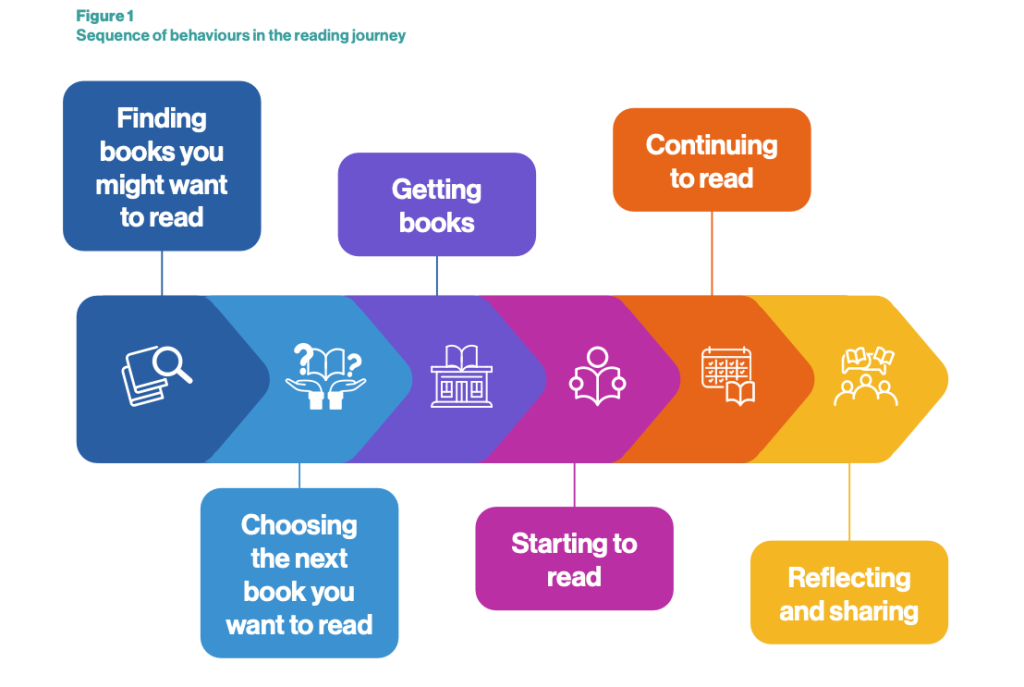Research shows that not enjoying or prioritising book browsing is a major barrier to reading for many people. So how do we make it easy and enjoyable for them?
As part of our recent Understanding Australian Readers report, behavioural scientists at Monash University broke down the act of reading into a series of behaviours: from finding and choosing books, to actually starting and continuing to read, to reflecting and sharing after you’ve finished a book.

The results showed that while many ‘avid’ readers love the book browsing process, more infrequent readers don’t – they’re getting stuck at the ‘finding books‘ and ‘choosing books’ stage.
You can’t read a book that you haven’t found, right?
So what’s the barrier here? The research highlights two connected reasons. The first is that infrequent readers don’t seem to enjoy the browsing process and, secondly, as such, don’t prioritise it as an activity in their daily lives.
So what can we do to make browsing books easier and more appealing for disengaged readers? And how can we integrate this into our bookstores, libraries or schools?
Show how it’s done
Knowing how to find books is a skill and can be developed. Having teachers, librarians and other book professionals demonstrate how to navigate the huge amount of books on offer and find your next great read is a helpful way to ‘upskill’ less confident browsers.
You could run a session on browsing at your library or bookstore, helping people to find the perfect gifts for their friends and family, or engage students in an interactive session on how to find books they might enjoy – for themselves and each other
‘Shelf-talkers’ are another classic way to help the casual browser – consider who’s writing those recommendations, and offer your community the chance to join in with their own recommendations for different types of readers.
Make it visible
The more we see books around us in daily life, the more likely we are to consider picking up a book and trying it out for ourselves.
Street Libraries provide the chance to get a glimpse at what your neighbours are reading, and try something new without any pressure.
No space for a street library? Install a recommendations board in your office or school, spaces that don’t require people to enter a bookish building – like shop windows, community noticeboards, and school entrance halls.
Make it fun
For our infrequent readers, who may be ambivalent or even lapsed readers, it’s important to re-frame browsing as an enjoyable and important activity in its own right, in ways that they find approachable.
Whether it’s setting interactive activities and challenges in the school library, or encouraging people to line up ‘book browsing dates’ with their friends, there’s a range of ways to make finding books a fun and sociable experience – and take the pressure off to find the perfect book first time.
Provide tools to make it quick and easy
For some people, wading through the huge number of books on offer might seem time consuming and overwhelming. But it doesn’t have to be – with the right tools.
Book subscription services like WellRead can help people feel less overwhelmed when it comes to finding their next read, and recommendation engines like Bookfinder can help find titles for younger readers.
Newsletters like LoveOzYA or Your Kid’s Next Read deliver targeted news about latest releases straight to your inbox, while reading guides like Good Reading and BookPeople’s seasonal reading guides can support more adept book seekers. Services like Libby are also developing tech-driven recommendation services to help match readers with their next read.
Show that support is on hand
It’s important to remind people that they’re not alone in book browsing and that help is on hand! Trained librarians and bookselling professionals are a great place to start for personalised reading recommendations; infrequent readers who aren’t regular visitors to bookshops and libraries may not be
Have you successfully run a book browsing initiative in your school, library or bookstore? We’d love to hear about it! Get in touch via email or our socials @australiareads.
Explore the Executive Summary and full findings of the Understanding Australian Readers report.

